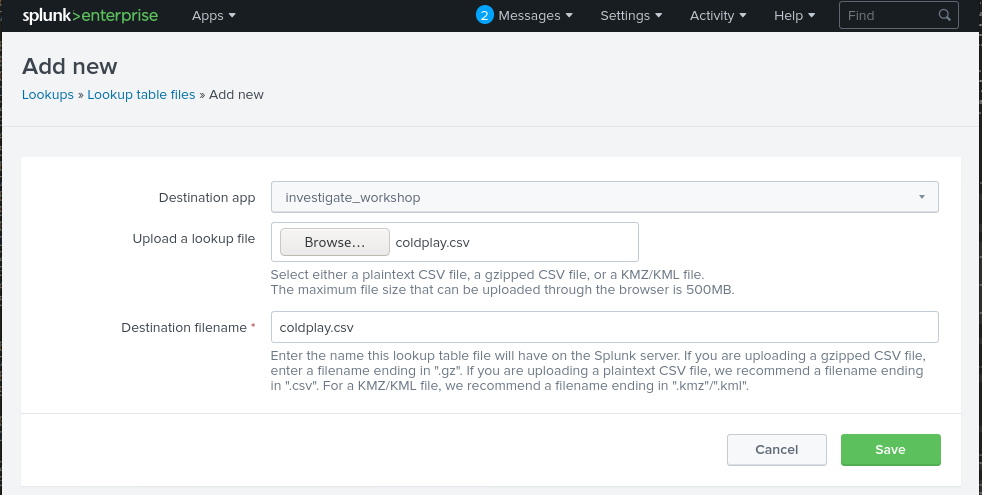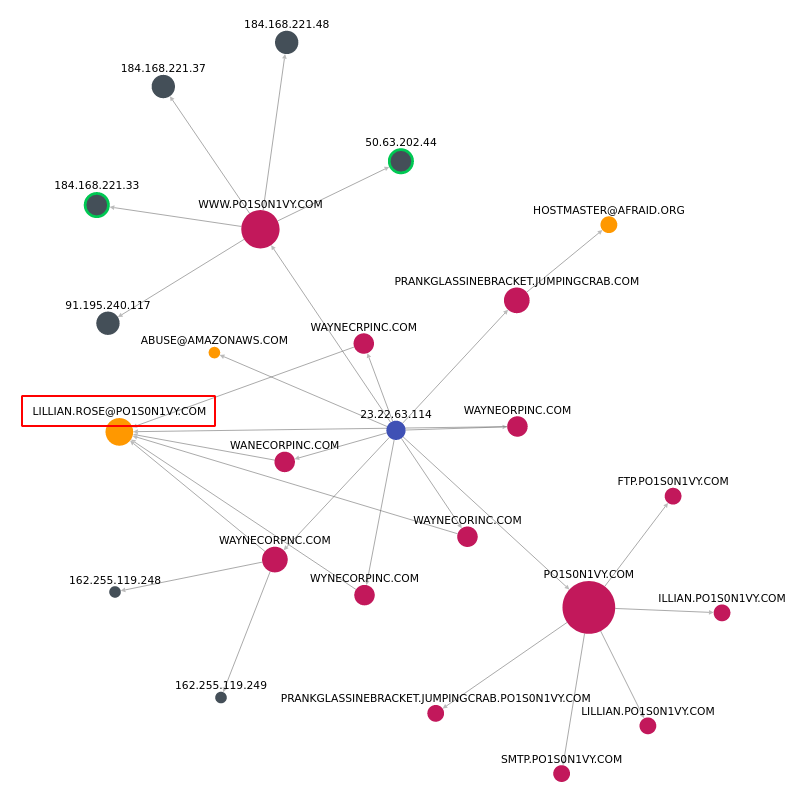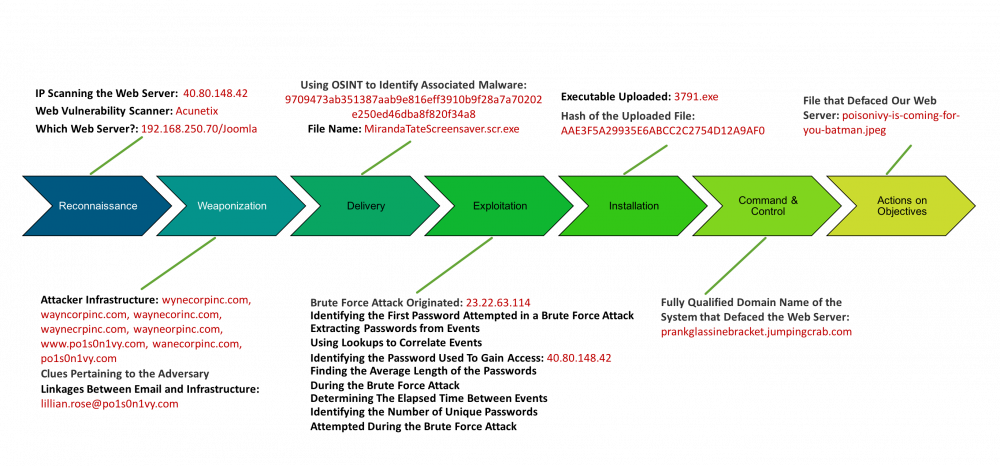TryHackMe-BP-Splunk/Advanced-Persitent-Threat
| You are here | Task 5 - Advanced Persistent Threat (APT)
|
[Task 5] Advanced Persistent Threat
Work your way through the first scenario in order to track down P01s0n1vy! Don’t hesitate to use the material provided to give you a nudge!
#1 - What IP is scanning our web server?
There are 2 indexes:
* | stats count by index
| index | count |
|---|---|
| botsv1 | 955807 |
| main | 5932 |
The 1st index does not seem to contain interesting data sources for our investigation:
* index=main | stats count by source | sort -count
| source | count |
|---|---|
| stream:Splunk_HTTPURI | 3708 |
| stream:Splunk_HTTPStatus | 686 |
| stream:Splunk_HTTPClient | 429 |
| stream:Splunk_HTTPResponseTime | 429 |
| stream:Splunk_IP | 247 |
| stream:Splunk_Tcp | 237 |
| stream:Splunk_Udp | 79 |
| stream:Splunk_DNSIntegrity | 40 |
| stream:Splunk_DNSClientQueryTypes | 36 |
| stream:Splunk_DNSRequestResponse | 23 |
| stream:Splunk_DNSServerQuery | 23 |
| stream:Splunk_DNSServerResponse | 23 |
As far as the second index:
* index=botsv1 | stats count by source | sort -count | head 10
| source | count |
|---|---|
| WinEventLog:Microsoft-Windows-Sysmon/Operational | 270597 |
| stream:smb | 151568 |
| /var/log/suricata/eve.json | 125584 |
| WinEventLog:Security | 87430 |
| udp:514 | 80922 |
| WinRegistry | 74720 |
| stream:ip | 62083 |
| stream:tcp | 28291 |
| stream:http | 23936 |
| C:3SVC1\u_ex160810.log | 22401 |
It is now obvious that the interesting information is in the botsv1 index.
index=botsv1 imreallynotbatman.com sourcetype=stream:http | stats count by src_ip | sort -count
| src_ip | count |
|---|---|
| 40.80.148.42 | 20932 |
| 23.22.63.114 | 1236 |
Answer: 40.80.148.42
#2 - What web scanner scanned the server?
index=botsv1 imreallynotbatman.com sourcetype=stream:http src_ip="40.80.148.42" | stats count by src_headers | sort -count | head 3
Top 3 requests should Acunetix (Free Edition) scanning requests:
POST /joomla/index.php/component/search/ HTTP/1.1 Content-Length: 99 Content-Type: application/x-www-form-urlencoded Cookie: ae72c62a4936b238523950a4f26f67d0=v7ikb3m59romokqmbiet3vphv3 Host: imreallynotbatman.com Connection: Keep-alive Accept-Encoding: gzip,deflate User-Agent: Mozilla/5.0 (Windows NT 6.1; WOW64) AppleWebKit/537.21 (KHTML, like Gecko) Chrome/41.0.2228.0 Safari/537.21 Acunetix-Product: WVS/10.0 (Acunetix Web Vulnerability Scanner - Free Edition) Acunetix-Scanning-agreement: Third Party Scanning PROHIBITED Acunetix-User-agreement: http://www.acunetix.com/wvs/disc.htm Accept: */* POST /joomla/index.php/component/search/ HTTP/1.1 Content-Length: 101 Content-Type: application/x-www-form-urlencoded Cookie: ae72c62a4936b238523950a4f26f67d0=v7ikb3m59romokqmbiet3vphv3 Host: imreallynotbatman.com Connection: Keep-alive Accept-Encoding: gzip,deflate User-Agent: Mozilla/5.0 (Windows NT 6.1; WOW64) AppleWebKit/537.21 (KHTML, like Gecko) Chrome/41.0.2228.0 Safari/537.21 Acunetix-Product: WVS/10.0 (Acunetix Web Vulnerability Scanner - Free Edition) Acunetix-Scanning-agreement: Third Party Scanning PROHIBITED Acunetix-User-agreement: http://www.acunetix.com/wvs/disc.htm Accept: */* POST /joomla/index.php/component/search/ HTTP/1.1 Content-Length: 102 Content-Type: application/x-www-form-urlencoded Cookie: ae72c62a4936b238523950a4f26f67d0=v7ikb3m59romokqmbiet3vphv3 Host: imreallynotbatman.com Connection: Keep-alive Accept-Encoding: gzip,deflate User-Agent: Mozilla/5.0 (Windows NT 6.1; WOW64) AppleWebKit/537.21 (KHTML, like Gecko) Chrome/41.0.2228.0 Safari/537.21 Acunetix-Product: WVS/10.0 (Acunetix Web Vulnerability Scanner - Free Edition) Acunetix-Scanning-agreement: Third Party Scanning PROHIBITED Acunetix-User-agreement: http://www.acunetix.com/wvs/disc.htm Accept: */*
Asnwer: acunetix
#3 - What is the IP address of our web server?
index=botsv1 imreallynotbatman.com sourcetype=stream:http src_ip="40.80.148.42" | stats count by dest_ip | sort -count
| dest_ip | count |
|---|---|
| 192.168.250.70 | 20931 |
| 192.168.250.40 | 1 |
Answer: 192.168.250.70
#4 - What content management system is imreallynotbatman.com using?
From the previous POST requests sent, we can easily guess that the CMS is Joomla. We can confirm with the top 10 URIs:
index=botsv1 imreallynotbatman.com sourcetype=stream:http src_ip="40.80.148.42" | stats count by uri | sort -count | head 10
| uri | count |
|---|---|
| /joomla/index.php/component/search/ | 14218 |
| /joomla/index.php | 798 |
| / | 517 |
| /windows/win.ini | 33 |
| /joomla/media/jui/js/jquery-migrate.min.js | 18 |
| /joomla/media/jui/js/jquery-noconflict.js | 18 |
| /joomla/administrator/index.php | 17 |
| /joomla/media/jui/js/bootstrap.min.js | 17 |
| /joomla/media/system/js/html5fallback.js | 13 |
| /joomla/templates/protostar/js/template.js | 13 |
Answer: joomla
#5 - What address is performing the brute-forcing attack against our website?
Requesting the HTTP methods shows a vast majority of POST requests:
index=botsv1 imreallynotbatman.com sourcetype=stream:http src_ip="40.80.148.42" | stats count by http_method | sort -count
| http_method | count |
|---|---|
| POST | 15146 |
| GET | 5766 |
| OPTIONS | 5 |
| CONNECT | 1 |
| PROPFIND | 1 |
| TRACE | 1 |
A brute force attack involves POST requests. In addition, it involves a username and a password. Let’s identify one of the requests:
index=botsv1 imreallynotbatman.com sourcetype=stream:http src_ip="40.80.148.42" http_method="POST" username | table dest_content | head 1
Result:
[REDACTED]
<form action="/joomla/administrator/index.php" method="post" id="form-login" class="form-inline">
[REDACTED]
<input name="username" tabindex="1" id="mod-login-username" type="text" class="input-medium" placeholder="Username" size="15" autofocus="true" />
[REDACTED]
<input name="passwd" tabindex="2" id="mod-login-password" type="password" class="input-medium" placeholder="Password" size="15"/>
[REDACTED]
<button tabindex="3" class="btn btn-primary btn-block btn-large">
<span class="icon-lock icon-white"></span> Log in </button>
[REDACTED]
<input type="hidden" name="option" value="com_login"/>
<input type="hidden" name="task" value="login"/>
<input type="hidden" name="return" value="aW5kZXgucGhw"/>
<input type="hidden" name="da4c70bcedf77f722881e18fb076b963" value="1" /> </fieldset>
</form>
[REDACTED]
From the above code, we see the structure of the authentication form; it is composed of a username field, a passwd field and a login field.
Let’s search for POST requests involving the username and passwd fields:
index=botsv1 imreallynotbatman.com sourcetype=stream:http http_method="POST" form_data=*username*passwd* | stats count by src_ip
Results:
| src_ip | count |
|---|---|
| 23.22.63.114 | 412 |
| 40.80.148.42 | 1 |
Interestingly, we see 1 request from 40.80.148.42 vs. 412 requests from 23.22.63.114. The brute force attack is coming from this latest.
Answer: 23.22.63.114
#6 - What was the first password attempted in the attack?
Based on our previous search, we can easily extract all probed username and passwords vs. time:
index=botsv1 imreallynotbatman.com sourcetype=stream:http http_method="POST" form_data=*username*passwd* | rex field=form_data "username=(?<u>\w+)" | rex field=form_data "passwd=(?<p>\w+)" | table _time, u, p | sort by _time | head 5
Results:
| _time | u | p |
|---|---|---|
| 2016-08-10 21:45:21.226 | admin | 12345678 |
| 2016-08-10 21:45:21.241 | admin | letmein |
| 2016-08-10 21:45:21.247 | admin | qwerty |
| 2016-08-10 21:45:21.250 | admin | 1234 |
| 2016-08-10 21:45:21.260 | admin | 123456 |
Answer: 12345678
#7 - One of the passwords in the brute force attack is James Brodsky’s favorite Coldplay song. Which six character song is it?
Go to https://en.wikipedia.org/wiki/List_of_songs_recorded_by_Coldplay and copy the table. Extract all the songs names (1st column) and save the file as coldplay.csv. You can download a copy here.
Now in Splunk, go to ‘Settings > Lookups > Lookup table files > Add New’.
Enter the following search to check that your file has successfully been imported:
| inputlookup coldplay.csv
Now, let’s search for a common value
index=botsv1 sourcetype=stream:http form_data=*username*passwd* | rex field=form_data "passwd=(?<userpassword>\w+)" | eval lenpword=len(userpassword) | search lenpword=6 | eval password=lower(userpassword) | lookup coldplay.csv song as password OUTPUTNEW song | search song=* | table song
Answer: yellow
#8 - What was the correct password for admin access to the content management system running imreallynotbatman.com?
Hint: Upon discovering a seemingly correct password, a password brute-forcing engine such as hydra will enter the password a second time to verify that it works.
The hint really helps. Let’s count the number of occurences for each password, and extract the one(s) with at least 2 occurences.
index=botsv1 imreallynotbatman.com sourcetype=stream:http http_method="POST" form_data=*username*passwd* | rex field=form_data "passwd=(?<p>\w+)" | stats count by p | where count>1 | table p
Result: batman
#9 - What was the average password length used in the password brute forcing attempt rounded to closest whole integer?
index=botsv1 imreallynotbatman.com sourcetype=stream:http http_method="POST" form_data=*username*passwd* | rex field=form_data "passwd=(?<p>\w+)" | eval pl=len(p) | stats avg(pl) as av | eval avg_count=round(av,0) | table avg_count
Answer: 6
#10 - How many seconds elapsed between the time the brute force password scan identified the correct password and the compromised login rounded to 2 decimal places?
As we have seen previously, 1 of the passwords (batman) was used 2 times. Let’s extract the timestamps for the occurences of this password.
index=botsv1 sourcetype=stream:http form_data=*username*passwd* | rex field=form_data "passwd=(?<p>\w+)" | search p="batman" | table _time, p, src_ip | sort by _time
| _time | p | src_ip |
|---|---|---|
| 2016-08-10 21:46:33.689 | batman | 23.22.63.114 |
| 2016-08-10 21:48:05.858 | batman | 40.80.148.42 |
Now, let’s use transaction to compute the delay between these timestamps.
index=botsv1 sourcetype=stream:http form_data=*username*passwd* | rex field=form_data "passwd=(?<p>\w+)" | search p="batman" | transaction p | eval dur=round(duration,2) | table dur
Answer: 92.17
#11 - How many unique passwords were attempted in the brute force attempt?
index=botsv1 imreallynotbatman.com sourcetype=stream:http http_method="POST" form_data=*username*passwd* | rex field=form_data "passwd=(?<p>\w+)" | dedup p | stats count
Answer: 412
#12 - What is the name of the executable uploaded by P01s0n1vy?
An upload form is usually structured as follows:
<form enctype="multipart/form-data" action="_URL_" method="post">
Let’s search for multipart/form-data:
index=botsv1 sourcetype=stream:http dest="192.168.250.70" "multipart/form-data" | head 1
Result:
{"endtime":"2016-08-10T21:52:47.035555Z","timestamp":"2016-08-10T21:52:45.437445Z","accept":"text/html, application/xhtml+xml, */*","accept_language":"en-US","ack_packets_in":1,"ack_packets_out":55,"bytes":77896,"bytes_in":77648,"bytes_out":248,"c_ip":"40.80.148.42","cached":0,"capture_hostname":"demo-01","client_rtt":0,"client_rtt_packets":0,"client_rtt_sum":0,"connection_type":"Keep-Alive","content_disposition":["form-data; name=\"userfile[0]\"; filename=\"3791.exe\"","form-data; name=\"userfile[1]\"; filename=\"agent.php\"","form-data; name=\"userfile[2]\"; filename=\"\"","form-data; name=\"userfile[3]\"; filename=\"\"","form-data; name=\"userfile[4]\"; filename=\"\"","form-data; name=\"userfile[5]\"; filename=\"\"","form-data; name=\"userfile[6]\"; filename=\"\"","form-data; name=\"overwrite_files\"","form-data; name=\"option\"","form-data; name=\"action\"","form-data; name=\"dir\"","form-data; name=\"requestType\"","form-data; name=\"confirm\""],"cookie":"7598a3465c906161e060ac551a9e0276=9qfk2654t4rmhltilkfhe7ua23","cs_cache_control":"no-cache","cs_content_length":77045,"cs_content_type":"multipart/form-data; boundary=---------------------------7e0e42c20990","cs_version":["1.1","1.1"],"data_center_time":1049868,"data_packets_in":55,"data_packets_out":1,"dest_content":"{'action':'upload','message':'Upload successful!','error':'Upload successful!','success':true}","dest_headers":"HTTP/1.1 200 OK\r\nContent-Type: text/html\r\nServer: Microsoft-IIS/8.5\r\nX-Powered-By: PHP/5.5.38\r\nDate: Wed, 10 Aug 2016 21:52:47 GMT\r\nContent-Length: 94\r\n\r\n","dest_ip":"192.168.250.70","dest_mac":"00:0C:29:C4:02:7E","dest_port":80,"duplicate_packets_in":52,"duplicate_packets_out":1,"http_comment":"HTTP/1.1 200 OK","http_content_length":94,"http_content_type":"text/html","http_method":"POST","http_referrer":"http://imreallynotbatman.com/joomla/administrator/index.php?option=com_extplorer&tmpl=component","http_user_agent":"Mozilla/5.0 (Windows NT 6.1; WOW64; Trident/7.0; rv:11.0) like Gecko","missing_packets_in":0,"missing_packets_out":0,"network_interface":"eth1","packets_in":56,"packets_out":56,"part_filename":["3791.exe","agent.php"],"reply_time":1049868,"request":"POST /joomla/administrator/index.php HTTP/1.1","request_ack_time":10,"request_time":548242,"response_ack_time":81928,"response_time":0,"sc_date":"Wed, 10 Aug 2016 21:52:47 GMT","server":"Microsoft-IIS/8.5","server_rtt":5934,"server_rtt_packets":26,"server_rtt_sum":154301,"site":"imreallynotbatman.com","src_content":"-----------------------------7e0e42c20990\r\nContent-Disposition: form-data; name=\"userfile[0]\"; filename=\"3791.exe\"\r\nContent-Type: application/octet-stream\r\n\r\nMZ�\u0000\u0003\u0000\u0000\u0000\u0004\u0000\u0000\u0000��\u0000\u0000�\u0000\u0000\u0000\u0000\u0000\u0000\u0000@\u0000\u0000\u0000\u0000\u0000\u0000\u0000\u0000\u0000\u0000\u0000\u0000\u0000\u0000\u0000\u0000\u0000\u0000\u0000\u0000\u0000\u0000\u0000\u0000\u0000\u0000\u0000\u0000\u0000\u0000\u0000\u0000\u0000\u0000\u0000�\u0000\u0000\u0000\u000E\u001F�\u000E\u0000�\t�!�\u0001L�!This program cannot be run in DOS mode.\r\r\n$\u0000\u0000\u0000\u0000\u0000\u0000\u0000�8���Y���Y���Y���E���Y��TE���Y���F���Y���F���Y���Y��\u001EY��TQ�Y���z���Y��\u0010_���Y��Rich�Y��\u0000\u0000\u0000\u0000\u0000\u0000\u0000\u0000\u0000\u0000\u0000\u0000\u0000\u0000\u0000\u0000PE
[REDACTED]
The interesting piece is part_filename":["3791.exe","agent.php"]. We’ll use this to run another search and extract the names of files that have been uploaded:
index=botsv1 sourcetype=stream:http dest="192.168.250.70" "multipart/form-data"
| stats count by part_filename{}
It results in 2 files:
| part_filename{} | count |
|---|---|
| 3791.exe | 1 |
| agent.php | 1 |
Answer: 3791.exe
#13 - What is the MD5 hash of the executable uploaded?
The MD5 hash seems to be available from 1 sourcetype:
index=botsv1 3791.exe md5 | stats count by sourcetype
| sourcetype | count |
|---|---|
| XmlWinEventLog:Microsoft-Windows-Sysmon/Operational | 67 |
Here is the request to extract the MD5:
index=botsv1 3791.exe sourcetype="XmlWinEventLog:Microsoft-Windows-Sysmon/Operational" CommandLine="3791.exe" | rex field=_raw MD5="(?<md5sum>\w+)" | table md5sum
Answer: AAE3F5A29935E6ABCC2C2754D12A9AF0
#14 - What is the name of the file that defaced the imreallynotbatman.com website?
In the attack phases, the attacker is likely to have found a vulnerability, and exploited it to download files from the server, to an external server. As we have already identified 2 IP addresses involved in the attack, let’s use them as destinations.
Let’s search for requests originating from the server, with suricata logs to 23.22.63.114:
index=botsv1 sourcetype="suricata" src_ip="192.168.250.70" dest_ip="23.22.63.114" | stats count by http.http_method, http.hostname, http.url | sort -count
Results:
| http.http_method | http.hostname | http.url | count |
|---|---|---|---|
| GET | imreallynotbatman.com | /joomla/administrator/index.php | 824 |
| POST | imreallynotbatman.com | /joomla/administrator/index.php | 411 |
| GET | 71.39.18.126 | /joomla/agent.php | 52 |
| GET | prankglassinebracket.jumpingcrab.com | /poisonivy-is-coming-for-you-batman.jpeg | 3 |
Answer: poisonivy-is-coming-for-you-batman.jpeg
#15 - This attack used dynamic DNS to resolve to the malicious IP. What fully qualified domain name (FQDN) is associated with this attack?
We already identified the FQDN in the previous request.
Answer: prankglassinebracket.jumpingcrab.com
#16 - What IP address has P01s0n1vy tied to domains that are pre-staged to attack Wayne Enterprises?
Answer: 23.22.63.114
#17 - Based on the data gathered from this attack and common open source intelligence sources for domain names, what is the email address that is most likely associated with P01s0n1vy APT group?
Googling for the IOCs collected so far leads to https://threatcrowd.org/ip.php?ip=23.22.63.114 where we are presented with a relationship diagram involving domains, IPs, emails:
Answer: [email protected]
#18 - GCPD reported that common TTPs (Tactics, Techniques, Procedures) for the P01s0n1vy APT group if initial compromise fails is to send a spear phishing email with custom malware attached to their intended target. This malware is usually connected to P01s0n1vy’s initial attack infrastructure. Using research techniques, provide the SHA256 hash of this malware.
Following online searches leads to https://www.threatminer.org/host.php?q=23.22.63.114 where we are provided with file hashes, 1 of which being identified as malicious by many AV solutions:
- aae3f5a29935e6abcc2c2754d12a9af0
- 39eecefa9a13293a93bb20036eaf1f5e
- c99131e0169171935c5ac32615ed6261 (malicious)
The last hash (https://www.threatminer.org/sample.php?q=c99131e0169171935c5ac32615ed6261) is associated with the following SHA256:
Answer: 9709473ab351387aab9e816eff3910b9f28a7a70202e250ed46dba8f820f34a8.
#19 - What special hex code is associated with the customized malware discussed in the previous question?
Looking for the hash on Virustotal (https://www.virustotal.com/gui/file/9709473ab351387aab9e816eff3910b9f28a7a70202e250ed46dba8f820f34a8/community) shows an hex string associated to this malware:
53 74 65 76 65 20 42 72 61 6e 74 27 73 20 42 65 61 72 64 20 69 73 20 61 20 70 6f 77 65 72 66 75 6c 20 74 68 69 6e 67 2e 20 46 69 6e 64 20 74 68 69 73 20 6d 65 73 73 61 67 65 20 61 6e 64 20 61 73 6b 20 68 69 6d 20 74 6f 20 62 75 79 20 79 6f 75 20 61 20 62 65 65 72 21 21 21
#20 - What does this hex code decode to?
$ echo "53 74 65 76 65 20 42 72 61 6e 74 27 73 20 42 65 61 72 64 20 69 73 20 61 20 70 6f 77 65 72 66 75 6c 20 74 68 69 6e 67 2e 20 46 69 6e 64 20 74 68 69 73 20 6d 65 73 73 61 67 65 20 61 6e 64 20 61 73 6b 20 68 69 6d 20 74 6f 20 62 75 79 20 79 6f 75 20 61 20 62 65 65 72 21 21 21" | xxd -r -p
Steve Brant's Beard is a powerful thing. Find this message and ask him to buy you a beer!!!
Summary
Based on our investigation, we can piece together what our adversary did: * Scanned for vulnerabilities * Found site is running Joomla * Performed a brute force password scan, logged into Joomla, installed file upload modules * Uploaded webshell * Used webshell to upload reverse TCP shell * Connected via metasploit * Tried to move around but couldn’t get out of locked down Windows 2012R2 * Defaced website with downloaded defacement image
Kill Chain
Threat picture - APT



